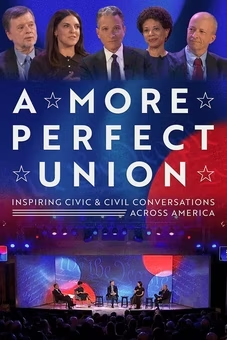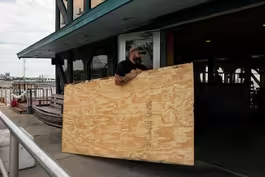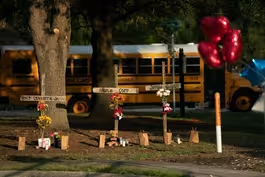
Landscape architect's goal of nature-based infrastructure
Clip: 8/29/2023 | 7m 33sVideo has Closed Captions
Landscape architect Kate Orff shares visionary goal of nature-based infrastructure
If you think of landscape architecture, you might conjure gardens and plantings. But in a rapidly changing climate fueled by intense heat, flooding, fires, smoke and hurricanes, architect and designer Kate Orff is helping redefine her field and push us all toward new climate adaptation solutions. Jeffrey Brown has the story for our arts and culture series, CANVAS.
Problems playing video? | Closed Captioning Feedback
Problems playing video? | Closed Captioning Feedback
Major corporate funding for the PBS News Hour is provided by BDO, BNSF, Consumer Cellular, American Cruise Lines, and Raymond James. Funding for the PBS NewsHour Weekend is provided by...

Landscape architect's goal of nature-based infrastructure
Clip: 8/29/2023 | 7m 33sVideo has Closed Captions
If you think of landscape architecture, you might conjure gardens and plantings. But in a rapidly changing climate fueled by intense heat, flooding, fires, smoke and hurricanes, architect and designer Kate Orff is helping redefine her field and push us all toward new climate adaptation solutions. Jeffrey Brown has the story for our arts and culture series, CANVAS.
Problems playing video? | Closed Captioning Feedback
How to Watch PBS News Hour
PBS News Hour is available to stream on pbs.org and the free PBS App, available on iPhone, Apple TV, Android TV, Android smartphones, Amazon Fire TV, Amazon Fire Tablet, Roku, Samsung Smart TV, and Vizio.
Providing Support for PBS.org
Learn Moreabout PBS online sponsorshipbut in a rapidly changing climate fueled# by the summer's intense heat, flooding,## fires, and now hurricanes, architect and# designer Kate Orff is helping redefine## her field and push us all toward# new climate adaptation solutions.
Jeffrey Brown has the story for our# arts and culture series, Canvas.
KATE ORFF, Landscape Architect:## We're here in Tottenville, which wa JEFFREY BROWN: A walk on# the shore of Staten Island,## New York, with landscape architect Kate Orff.
But this is no day at the beach.# And despite the gentle lapping of## water on a hot summer morning, this# is anything but a healthy coastline.
In 2012, this area was overwhelmed by the# storm surge caused by Hurricane Sandy,## which caused widespread flooding in many# parts of New York City.
More than half of## the 43 people killed were on Staten Island.# And the destruction extended well inland.
Eleven years later, Kate Orff is watching the# final stages of an experiment she hopes can point## the way towards a healthier ecosystem and mitigate# future disasters.
It's called Living Breakwaters.
KATE ORFF: The breakwaters are kind of a# strategy about helping to slow the water,## helping to clean the water, helping to replenish# this incredibly eroded shoreline, actually reverse## erosion, and then start to rebuild this kind of# critical three-dimensional mosaic of subtidal and## intertidal rock marine ecosystem that we have# literally decimated in the New York Harbor.
It's down to about 1 percent of its former extent.
JEFFREY BROWN: Orff is founder of the# design firm SCAPE based in Sh e is a leading voice in her field pushing# efforts to address the climate crisis and## its many impacts.
She was the first landscape# architect to receive a MacArthur genius award,## directs the Urban Design Program# at Columbia University, and this## year was named to the TIME 100 of the# most influential people in the world.
One mantra, adapting to a changing climate,# requires adapting her own profession.
KATE ORFF: It requires rethinking# our training, our perspective,## our assumptions about what is land, what# is water, what is engineering, what is art?
I think every profession today is now your# existing profession, plus climate emergency.
JEFFREY BROWN: You use the term climate# adaptation clearly behind a lot of what## you're after.
What does climate adaptation mean?
KATE ORFF: Climate adaptation in the built# environmen view at what we have built now and where we# have built, and how can we -- knowing that## all of these sort of factors are in flux, what# can we do to look at that built environment in## a synthetic and holistic way and try to make# adaptations to make us safer in the future?
And a lot of times, the answers are murky.
JEFFREY BROWN: Like the waters of Raritan# Bay, where the Living Breakwaters are being## constructed, with $107 million in funding by# New York state and the federal government.
The idea, build a set of barriers that will# hold back water with eight partially submerged## structures of stones and concrete.
A nonprofit# called the Billion Oyster Project will seed the## structures with oyster larvae, eventually# recreating an oyster reef, a return to an## earlier era, when oysters were an enormous part# of New York's economy and natural ecosystem.
The oyster as an answer to# a lot of these problems?
KATE ORFF: This would have# been a thriving salt marsh.## You would have had oyster reefs covering the bay.
JEFFREY BROWN: Which would# have prevented erosion, yes.
KATE ORFF: Right.
And these inta And so the oyster is a Keystone of# that landscape.
And the reason is,## it is -- it kind of can create reefs.
It can# build up.
It can form wave-attenuating reefs.## It's food for migrating birds.
It creates# shallow waters for the horseshoe crab.
It## kind of sets into motion these more sort of# shallow, intertidal, protective landscapes.
JEFFREY BROWN: So the idea is millions or# a billion oysters create a new ecosystem?
KATE ORFF: Right.
And we have to start,## so oyster is the first step.
It's not# the answer JEFFREY BROWN: It's a step that's catching on,## including a similar smaller project highlighted# on the "NewsHour Orff herself is working at sites around# the country and, more and more, the globe,## mostly small-scaled, client-driven projects.## But she wants to work and wants us to think# bigger, a Mississippi River National Park,## for example, bold, transformative# ideas for the American landscape.
If all of this is so obvious, why isn't# it the norm?
What are the barriers?
KATE ORFF: And the barriers are many,# right?
These big projects that we need## to conceive of that may cross state# boundaries, they may cross watershe They certainly will cross city boundaries.# They're really more at a regional scale,## kind of don't have an owner, if you will, or# a way to kind of like nest into the system.
JEFFREY BROWN: What's your job# in making us see it differently?
KATE ORFF: Right.
or you can't do this, you can't drive this way,# you can't put your house on this coastline.
JEFFREY BROWN: And then people say... KATE ORFF: And JEFFREY BROWN: Yes rich, textured environmental future# that we should be running towards.
JEFFREY BROWN: When you talk about# changing the way landscape architecture## or other parts of the design world# are done, you include activism.
KATE ORFF: That's right.
We can't just# be passively accepting and assuming## what's -- what's coming on the plate is# not what needs to be done.
We need to be## defining the projects that are happening# or that are coming our way.
And so... JEFFREY BROWN: You mean you want to be putting the## projects forward or the designs# KATE ORFF: Yes.
I want to be# suggesting w JEFFREY BROWN: Another part of her practi schools on Staten Island to# get young students involved.
Knowledge and ownership, she believes,# are fundamental to any future ch KATE ORFF: There's this sense of# despair, frankly.
There's a sense of,## I'm inheriting a world that I did not# make and that I am now responsible for.
And I just feel like its too much of a# cop-out to say to the next generation,## oh, you're going to be the solvers.# That's really not fair.
I really want## to feel like they -- that we are making# a huge difference and that we're at least## setting a pathway that these students feel# like they can -- they can see themselves on.
JEFFREY BROWN: Her hope, one day soon,# that will include enjoying a healthy and## inviting beach near home.
Completion of the Living# Breakwaters is expected by the end of next year.
For the "PBS NewsHour," I'm Jeffrey# Brown on Staten Island, New York.
Conservatives fight socially conscious investments
Video has Closed Captions
Clip: 8/29/2023 | 8m 51s | Conservatives fight back against environmental and socially conscious investments (8m 51s)
Hurricane Idalia intensifying ahead of Florida landfall
Video has Closed Captions
Clip: 8/29/2023 | 6m 46s | Hurricane Idalia intensifying as it heads for landfall on Florida's Gulf Coast (6m 46s)
Jacksonville mayor discusses racist shooting that killed 3
Video has Closed Captions
Clip: 8/29/2023 | 6m 21s | Jacksonville mayor discusses city's response to racist shooting that left 3 dead (6m 21s)
Meadows' testimony in Georgia could shape case against Trump
Video has Closed Captions
Clip: 8/29/2023 | 5m 47s | How Meadows' testimony in Georgia could help shape case against Trump (5m 47s)
Medicare price negotiations could save government billions
Video has Closed Captions
Clip: 8/29/2023 | 6m 38s | Medicare drug price negotiations could save government billions (6m 38s)
New podcast reveals how female patients' pain often ignored
Video has Closed Captions
Clip: 8/29/2023 | 6m 36s | Podcast 'The Retrievals' reveals painful experiences of female patients are often ignored (6m 36s)
Providing Support for PBS.org
Learn Moreabout PBS online sponsorship
- News and Public Affairs

FRONTLINE is investigative journalism that questions, explains and changes our world.

- News and Public Affairs

Amanpour and Company features conversations with leaders and decision makers.
Urban Consulate Presents











Support for PBS provided by:
Major corporate funding for the PBS News Hour is provided by BDO, BNSF, Consumer Cellular, American Cruise Lines, and Raymond James. Funding for the PBS NewsHour Weekend is provided by...





